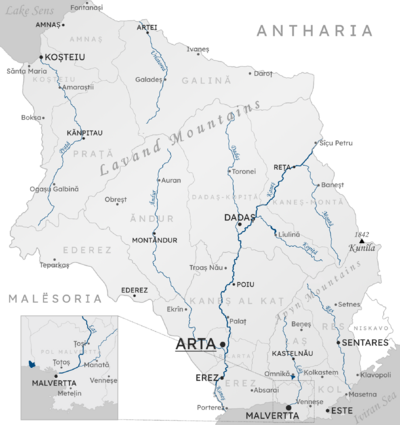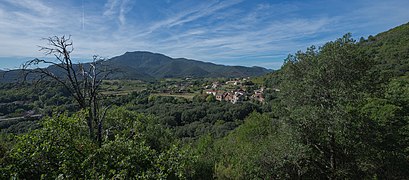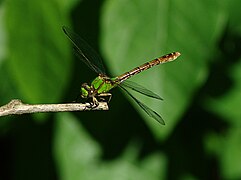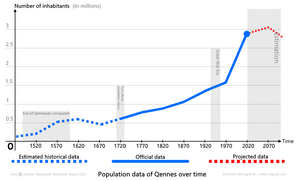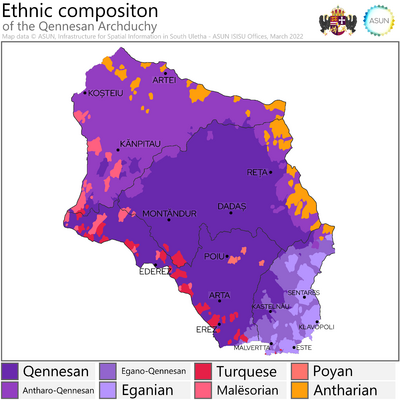Qennes: Difference between revisions
Bixelkoven (talk | contribs) m (→Protection) |
Bixelkoven (talk | contribs) m (→Municipalities) |
||
| Line 361: | Line 361: | ||
{| class="wikitable sortable" style="text-align: center;" | {| class="wikitable sortable" style="text-align: center;" | ||
! rowspan=2 | Municipality | ! rowspan=2 | Municipality (Code) | ||
! class=unsortable rowspan=2 | Coat of Arms | ! class=unsortable rowspan=2 | Coat of Arms | ||
! rowspan=2 | Adm. centre | ! rowspan=2 | Adm. centre (Code) | ||
! rowspan=2 | Number of cities | ! rowspan=2 | Number of cities | ||
! class="unsortable" colspan=2 | Land area | ! class="unsortable" colspan=2 | Land area | ||
| Line 374: | Line 374: | ||
! scope="col"|inhab./mi² | ! scope="col"|inhab./mi² | ||
|- | |- | ||
| '''{{relation|184518|Amnaş}}''' | | '''{{relation|184518|Amnaş (AȘ)}}''' | ||
| [[File:CoAAmnas.png|100x70px|center]] | | [[File:CoAAmnas.png|100x70px|center]] | ||
| {{node|179130245|Amnaş}} | | {{node|179130245|Amnaş (AȘ)}} | ||
| '''2''' | | '''2''' | ||
(Amnaș, Fontanași) | (Amnaș, Fontanași) | ||
| Line 385: | Line 385: | ||
| 358 | | 358 | ||
|- | |- | ||
| '''{{relation|269108|Reḑionu Kapital ḑe Arta}}''' | | '''{{relation|269108|Reḑionu Kapital ḑe Arta (AR)}}''' | ||
| [[File:CoAArta.png|100x70px|center]] | | [[File:CoAArta.png|100x70px|center]] | ||
| {{node|179130276|Arta}} | | {{node|179130276|Arta (AR)}} | ||
| '''1''' | | '''1''' | ||
(Arta) | (Arta) | ||
| Line 396: | Line 396: | ||
| 1,868 | | 1,868 | ||
|- | |- | ||
| '''{{relation|184515|Galină}}''' | | '''{{relation|184515|Galină (GA)}}''' | ||
| [[File:Artei.png|100x70px|center]] | | [[File:Artei.png|100x70px|center]] | ||
| {{node|179130247|Artei}} | | {{node|179130247|Artei (AE)}} | ||
| '''4''' | | '''4''' | ||
(Artei, Daroț, Galadeș, Ivaneș) | (Artei, Daroț, Galadeș, Ivaneș) | ||
| Line 407: | Line 407: | ||
| 276 | | 276 | ||
|- | |- | ||
| '''{{relation|184512|Dadaş - Kopiță}}''' | | '''{{relation|184512|Dadaş - Kopiță (DK)}}''' | ||
| [[File:CoADadas.png|100x70px|center]] | | [[File:CoADadas.png|100x70px|center]] | ||
| {{node|179130278|Dadaş}} | | {{node|179130278|Dadaş (DD)}} | ||
| '''3''' | | '''3''' | ||
(Dadaş, Lîulină, Toronei) | (Dadaş, Lîulină, Toronei) | ||
| Line 418: | Line 418: | ||
| 288 | | 288 | ||
|- | |- | ||
| '''{{relation|184514|Ederez}}''' | | '''{{relation|184514|Ederez (ED)}}''' | ||
| [[File:CoAEderez.png|100x70px|center]] | | [[File:CoAEderez.png|100x70px|center]] | ||
| {{node|179130269|Ederez}} | | {{node|179130269|Ederez (ED)}} | ||
| '''2''' | | '''2''' | ||
(Ederez, Teparkaş) | (Ederez, Teparkaş) | ||
| Line 429: | Line 429: | ||
| 331 | | 331 | ||
|- | |- | ||
| '''{{relation|184510|Erez}}''' | | '''{{relation|184510|Erez (EZ)}}''' | ||
| [[File:FlagErez.png|100x70px|center]] | | [[File:FlagErez.png|100x70px|center]] | ||
| {{node|179130282|Erez}} | | {{node|179130282|Erez (EZ)}} | ||
| '''3''' | | '''3''' | ||
(Absarai, Erez, Porterez) | (Absarai, Erez, Porterez) | ||
| Line 440: | Line 440: | ||
| 2,268 | | 2,268 | ||
|- | |- | ||
| '''{{relation|250853|Kol}}''' | | '''{{relation|250853|Kol (KO)}}''' | ||
| [[File:CoAEste.png|100x70px|center]] | | [[File:CoAEste.png|100x70px|center]] | ||
| {{node|179130280|Este}} | | {{node|179130280|Este (EE)}} | ||
| '''4''' | | '''4''' | ||
(Este, Kolkastem, Masetna, Venneșe) | (Este, Kolkastem, Masetna, Venneșe) | ||
| Line 451: | Line 451: | ||
| 5,022 | | 5,022 | ||
|- | |- | ||
| '''{{relation|184516|Prață}}''' | | '''{{relation|184516|Prață (PR)}}''' | ||
| [[File:Kanpitau.png|100x70px|center]] | | [[File:Kanpitau.png|100x70px|center]] | ||
| {{node|179130272|Kănpitau}} | | {{node|179130272|Kănpitau (KP)}} | ||
| '''2''' | | '''2''' | ||
(Kănpitau, Ogașu Galbină) | (Kănpitau, Ogașu Galbină) | ||
| Line 462: | Line 462: | ||
| 318 | | 318 | ||
|- | |- | ||
| '''{{relation|249208|Laş}}''' | | '''{{relation|249208|Laş (LA)}}''' | ||
| [[File:CoAKastelnau.png|100x70px|center]] | | [[File:CoAKastelnau.png|100x70px|center]] | ||
| {{node|179130253|Kastelnău}} | | {{node|179130253|Kastelnău (KS)}} | ||
| '''3''' | | '''3''' | ||
(Kastelnău, Omnikă, Beņeș) | (Kastelnău, Omnikă, Beņeș) | ||
| Line 473: | Line 473: | ||
| 837 | | 837 | ||
|- | |- | ||
| '''{{relation|184517|Koşteiu}}''' | | '''{{relation|184517|Koşteiu (KȘ)}}''' | ||
| [[File:CoAKosteiu.png|100x70px|center]] | | [[File:CoAKosteiu.png|100x70px|center]] | ||
| {{node|179130277|Koşteiu}} | | {{node|179130277|Koşteiu (KȘ)}} | ||
| '''4''' | | '''4''' | ||
(Amaraștii, Boksa, Koșteiu, Săntă Maria) | (Amaraștii, Boksa, Koșteiu, Săntă Maria) | ||
| Line 484: | Line 484: | ||
| 1,644 | | 1,644 | ||
|- | |- | ||
| '''{{relation|249207|Malvertta}}''' | | '''{{relation|249207|Malvertta (MA)}}''' | ||
| [[File:CoAMalvertta.png|100x70px|center]] | | [[File:CoAMalvertta.png|100x70px|center]] | ||
| {{node|179130281|Malvertta}} | | {{node|179130281|Malvertta (MA)}} | ||
| '''5''' | | '''5''' | ||
(Malvertta, Țoși, Țoțoș, Meteļin, Manată) | (Malvertta, Țoși, Țoțoș, Meteļin, Manată) | ||
| Line 495: | Line 495: | ||
| 15,803 | | 15,803 | ||
|- | |- | ||
| '''{{relation|184513|Ăndur}}''' | | '''{{relation|184513|Ăndur (ĂN)}}''' | ||
| [[File:CoAMontandur.png|100x70px|center]] | | [[File:CoAMontandur.png|100x70px|center]] | ||
| {{node|179130268|Montăndur}} | | {{node|179130268|Montăndur (MĂ)}} | ||
| '''3''' | | '''3''' | ||
(Auran, Montăndur, Obreșt) | (Auran, Montăndur, Obreșt) | ||
| Line 506: | Line 506: | ||
| 237 | | 237 | ||
|- | |- | ||
| '''{{relation|269107|Kaneș al Kaț}}''' | | '''{{relation|269107|Kaneș al Kaț (KȚ)}}''' | ||
| [[File:CoAPoiu.png|100x70px|center]] | | [[File:CoAPoiu.png|100x70px|center]] | ||
| {{node|226029993|Poiu}} | | {{node|226029993|Poiu (PO)}} | ||
| '''4''' | | '''4''' | ||
(Ekrîn, Palaț, Poiu, Troaș Nău) | (Ekrîn, Palaț, Poiu, Troaș Nău) | ||
| Line 517: | Line 517: | ||
| 450 | | 450 | ||
|- | |- | ||
| '''{{relation|184511|Kaneș - Montă}}''' | | '''{{relation|184511|Kaneș - Montă (KM)}}''' | ||
| [[File:CoAReta.png|100x70px|center]] | | [[File:CoAReta.png|100x70px|center]] | ||
| {{node|179130260|Reța}} | | {{node|179130260|Reța (RE)}} | ||
| '''3''' | | '''3''' | ||
(Baneșt, Reța, Sîc̣u Petru) | (Baneșt, Reța, Sîc̣u Petru) | ||
| Line 528: | Line 528: | ||
| 268 | | 268 | ||
|- | |- | ||
| '''{{relation|184507|Res}}''' | | '''{{relation|184507|Res (RS)}}''' | ||
| [[File:FlagRes.png|100x70px|center]] | | [[File:FlagRes.png|100x70px|center]] | ||
| {{node|179130279|Sentares}} | | {{node|179130279|Sentares (SE)}} | ||
| '''3''' | | '''3''' | ||
(Klavopoli, Sentares, Setnes) | (Klavopoli, Sentares, Setnes) | ||
Revision as of 00:01, 15 April 2022

|
Qennes Arkiduțiă Kaneșului (Qennesan) Archidoucatul Quenneʃ (Romanish) Arkidukat Kenes (Eganian) Kanıs Arşidüklüğü (Turquese) Kryedukati i Kenes (Malësorian) Arȿiḏucijȁ Ḵenɘs (Poyan) Capital: Arta
Population: 2,976,958 (2017) Motto: Iața Kaneșienii Anthem: Frumosă noastră ḑintre Lină Tîrdau șî Mar Iviran |
Loading map... |
Qennes (/kɛnes/, pronounced: KE-nes; Qennesan: Kaneș, pronounced: [känɛʂ], KA-nesh), officially The Qennesan Archduchy (Qennesan: Arkiduțiă Kaneșului), is a sovereign state in central-southern Uletha. It is bordered by Malësoria to the west, Antharia to the north and east, and Niscavo to the southeast. It also borders The Demirhan Empire to the south via the Bay of Erez, part of the Iviran Sea on which Qennes has it's southern shores, while the northwestern shores are located on the Lake Sens.
Qennes has a population of almost 3 million people which is spread out on 9,846 square kilometers. It is one of the most densely populated countries in south Uletha.
Qennes is an elective monarchy, ruled by an archduke. It is a member of the Association of South Ulethan Nations. The capital city is Arta located in the southwest of the country, while the largest city is Malvertta.
| Qennes Kaneș The Qennesan Archduchy Template:Collapsible list | |||||
|---|---|---|---|---|---|
| |||||
Loading map... | |||||
| Motto: "Iața Kaneșienii." Behold the Qennesan people. (in) | |||||
| Anthem: Frumosă noastră ḑintre Lină Tîrdau șî Mar Iviran (qn) Our beauty between Lake Sens and the Iviran Sea (in) | |||||
| Capital | Arta | ||||
| Largest city | Malvertta | ||||
| Official languages | Qennesan | ||||
| • Regional languages | Romanish Eganian Turquese Malësorian Poyan | ||||
| Ethnic Groups (2019) | Qennesan Romanish Eganian Erez Turquese Malësorian Poyan | ||||
| Demonym | Qennesan | ||||
| Government | Electoral Monarchy (Archduchy) | ||||
| • Archduke (Arkidukî) | Maksim III Maran | ||||
| • Arch-House Principal (Prințipel ḑe Kasă Națională) | Aleksandru Buļioț | ||||
| • Representative of the Nobility (Reprezentant ḑe Nobiļimii) | Eugenia VII Torlak | ||||
| • Representative of the Peasantry Union (Reprezentant ḑe Unii Țărăņimii) | Ionuț Ilionesku | ||||
| Legislature | Kasă Națională ḑe Arkiduțiă (qn) National Arch-House (in) | ||||
| • Upper house | Nobiļimiea (qn) The Nobility (in) | ||||
| • Lower house | Unii Țărăņimii (qn) The Peasantry Union (in) | ||||
| Area | |||||
| • Total | [1]10,363.18 km2 [2]4,001.25 sq mi | ||||
| • Water (%) | 6.68 | ||||
| Population | |||||
| • Estimate (2021) | 2,987,030 | ||||
| • Census (2017) | |||||
| • Density | 307.8/km2 797.25/sq mi | ||||
| GDP (PPP) | |||||
| • Total | |||||
| • Per capita | |||||
| HDI (2021) | very high | ||||
| Timezone | WUT +5 | ||||
| Currency | Qennesan Lîu (QNL) | ||||
| Drives on the | right | ||||
Etymology
The name Qennes is the Ingerish version of the native name Kaneș. The name 'Qennes' gets its roots from the Romanish name for the coastal area west of Niscavo - Quenneʃ.
Kaneș, as a name, has no certain etymology although there are two possible answers. During the Hellanesian colonization of the coast west of Niscavo, the area was uninhabited upon arrival. It is thought that the colonizers named the region Keno, Kene, Kenos or either Kenes, all of which derive from the Hellanesian word keno, meaning "empty". It is considered that the name eventually became the name of the Hellanesian subdivision in the area.
Another suggestion is that the name was derived from the phrase 'Kan nisi' , which means "possibly an island" in Hellanesian. It is thought that the colonizers have mistaken the peninsula in nowadays Malvertta for an island, or were either uncertain if it is either of the two.
The name Kaneș was first recorded in 1427 when Qennes' borders where roughly at the lines with nowadays Lipămontală∈⊾ province. Before that date, Qennes was known as 'Kenes' by the Hellanesians, 'Quenneʃ' by the Romanish and 'Kanis' by the Turquese. Since 1427 the name has remained unchanged.
History
Prehistory
Early history
Hellanesian colonization era
Independence years
Post-Independence years
Darazdinian state
Antharian Kingdom
Medieval Era
Anagenisi Period
Romanish invasion
Neo-Hellanesian colonization era
Early modern era
Great War era
Modern era
Geography
 | |
|---|---|
| Geography of Qennes | |
| Continent | Uletha (Western) |
| Region | Iviran Coast |
| Population | |
| Area | |
| • Total | 10,363.18 km2 4,001.25 sq mi |
| • Water (%) | 6.68% |
| Population density | 307.8 km2 797.25 sq mi |
| Extreme points | Kunîla (1842 m) Iviran Sea∈⊾ (0 m) |
| Longest river Largest lake (by area) | Kaneș (x) Lake Omnikă (Lină Omnikă) (x) |
| Time zone | WUT +5 |
Qennes is situated on the continent of Uletha, in its central-southern region known as the Iviran Coast, by the Iviran Sea∈⊾. It lies between latitudes 41° and 40° N, and longitudes 83° and 84.5° E. The geographic center of Qennes is located west of the city of Dadaș, on the AP-3 highway, at the coordinates of 40.2462° N and 83.719° E, near the village of Brațaș.
Qennes is a moderately hilly nation, with two major mountain chains spanning east to west. They are the Lavand Mountains in the central areas of the country and the Apyn Mountains in the southeast, both of which span east into Antharia and Niscavo. The tallest peak, Kunîla, standing at 1842 meters, is located in the Apyn Mountains range on the tripoint of the municipalities of Kaneș-Montă∈⊾, Res∈⊾ and the country of Antharia. Most of the country is dominated by rolling hills, river valleys and flat plains. The three major plains in Qennes are the Koșteiu Plain, the Erez Plain, home to most of the agriculture activity, and the Qennesan Riviera Region - the most densely populated area in the country, as well as a tourist hotspot. The lowest point of Qennes is the Asperic Ocean at sea level (0m), with no stretches of land under sea level.
- Landscapes of Qennes
Salterns in Viletta
Geology
Qennes is in a semi-active seismic zone. It lies near the active convergent boundary of the Asperic and East Ulethan plates.[3] There have been at least 50 destructive earthquakes in the past identified by scientists. There are numerous caves throughout Qennes, found throughout the hilly and mountainous regions of the country. In the Feră Empodia region, grottoes are a dotted along the cliffs. There are about 70 grottoes in Qennes. The rock composition is predominantly sedimentary, and the soil is favorable for year-round agricultural activity in every part of the country.
|
| ||||||||||||||||||||||||||||||||||||||||||||||||||||||||||||||||||||||||||||||||||||||||||||||||||||||||||||||||||||||||||||||||||||||||||||||||||||||||||||||||||||||||||||||||||||||||||||||||||||||||||||||||||||||||||||||||
Climate
As a rather small sized country, Qennes doesn't pose much diversity in climate. There are 2 climate zones in Qennes: 'Csa' encompasses most of the country, while the highest of mountains and peaks are classifed as 'Csb'. Qennes is characterized by dry summers and mild, wet winters.
The precipitation rate varies between 35mm and 94mm year round. The rainfall rarely exceeds 150mm during a month, and the average amount of rainfall is 64mm. Qennes receives about 3,712 hours of sunshine year round, with the numbers peaking at 384 hours in July. Such a climate has allowed Qennes to develop into a highly popular summer tourism destination.
Waters
All of Qennes' rivers belong to the Iviran Sea∈⊾ basin. They are either directly part of the drainage basin, or part of the Lake Sens∈⊾ drainage basin, which empties into the Iviran Sea via the Recz River in Antharia.
The longest river is the Kaneș River with a length of XXXm (XXXm of which is within the borders of Qennes). It has it source near the monastery of Pakras in western Antharia, flowing southwest towards the Bay of Erez where it meets the Iviran Sea next to the town of Porterez. On its course it flows through a few major cities and towns including Kallomenos (Antharia), Reța, Dadaș, Poiu, Arta, Erez, Porterez (Qennes) and Portilumës (Malësoria). Qennes has a low number of natural lakes and ponds. Besides the Lake Sens, the largest natural lake would be Lake Omnikă in the south of the country, created by a natural phenomenon of beavers constructing a dam on the Omnikă River strong enough to dam the small river. This enabled engineers to find the perfect spot for a dam.
Other natural lakes can be mainly found in the southwest, precisely oxbow lakes created by the Kaneș River and its meandering. The largest lake, besides the Lake Sens, is the Lîulină Reservoir, created artificially by the Lîulină Dam on the Kopiță River.
Biodiversity & Protected Areas
Qennes has a wide number of animal, plant and fungi species present in its territory. It is one of the most biodiverse countries in southern Uletha, proportional to its territory size. In 2008, Qennes brought a Biodiversity Recognition law into power, which revised the biodiversity situation in the country and set to protect endangered species, and control the human usage of natural resources of the nature. Alongside that, Qennes redefined its protected areas, and redefined the areas which are considered to be protected.
There are 3 main terrestrial biogeographical and eco-regions: Littoral, Lower Continental and Upper Continental. The Littoral regions is dominated by the Mediterranean biome, mainly hot and dry summers, and rainy and semi-rainy winters, forests and shrubs of lower density, plants which can be pyrophytes, numerous cases of the "mosaic habitat" and general drier scenery. It is found along the coast of Qennes, forming a belt of maximum 5km in width. It is by far the smallest of the three regions.
The Lower Continental regions are located at lower lying areas throughout continental Qennes, mainly among the elevating range between 150 and 800 meters. It is characterized by a semi-drier climate, a more denser vegetation rate, higher density of animal species, and lower amount of mosaic habitats. It is a transition zone between the much drier Littoral and the less drier Upper Continental. Numerous and larger oak and beech forests, garrigues (phryganas), matorrals and other types of shrubs can be found here. The zone has the highest average temperature among the three areas, the lowest rainfall and therefore the highest chance of catching natural wildfires, but also man-made forest fires, which can happen during the stubble burning season in rural areas, since this zone account for 80% of the agricultural activity in the country. Stubble burning is considered a problem of the past, but is still present in northern and eastern regions of the country.
The Upper Continental regions are located at the highest of elevations in the country, everything above 800 meters. It is dominant in denser forests and woodlands, less so in shrubs and bushes. It includes forests of oaks, pines, conifers, and maqius shrublands. It presents a larger precipitation rates compared to the Lower Continental regions, but also lower temperatures, the lowest in the country, often falling below zero. These regions see minimal agricultural activity but the largest forestry activity amongst the three. It accounts for about 70% of Qennes' forested areas, and since the 2008 law, the area size of the forested lands has increased drastically, as numerous tree-planting activities were introduced to preserve and increase the forested lands. Qennes is still however one of the least forested nations in Uletha.
Flora & Fauna
Qennes has a wide variety of plants and animals which are found in the whole of south Uletha. Dominant tree types include: oaks, pines, conifers, beech, olive trees, palms, fig trees, holm oaks, cork oaks, chestnuts, grapevines, magnolias, ficus trees, Curtisia, etc. A notable species of trees prevalent in Qennes are the 'Red Robin' trees. Among other plants, Qennes is home to the: flowering ash, Gleditsia, Jujube, grey elms, Pompia, azeroles, hawthorns, matorral, garrigue, maqius, etc. Traditional crops include: grapes, olives, figs, pomegranates, oranges, apricots, lemons, tangerines, and others, mainly grown for commercial purposes and exports, alongside typical crops like wheat, corn, barley, various vegetables, fruits and nuts which are mainly for domestic consumption.
Animals prevalent in the region can be found in Qennes as well. There are about 100 animal species, and they include: various sponges, corals, sea anemones, starfishes, sea cucumbers, sea snails, sea worms, octopuses, jellyfish, and a noticeable amount of crabs (which gave the name of the region in southeast Qennes and Niskavo - Klavia/Niskavo), lobsters and prawns - for the sea ecoregion. Terrestrial animals include: durmouses, mouses, rats, shrews, voles, bats, wolfs, chamois, deers, dolphins, snakes, lizards, butterflies, dragonflies, Praying mantises, cicadas, glow-worms, hawk-moths, stinkbugs, crickets, hornets, wasps, bees, beetles, toads, salamanders, newts, turtles, ray-finned fish, eels, carps, various other fishes, and various domesticated animals like horses, cows, sheep, goats, pigs, etc. The common yellow swallowtail butterfly and the green snaketail dragonfly are the national animals of Qennes.
- Animals of Qennes
Protection
There are a total of X[4] protected areas in Qennes. There are 6 protection categories for areas and 4 for the protection of members of the Qennesan flora & fauna. They are:
- Protection classes for areas, highest level of protection to lowest:
- Geopark - A large unified protected area that advances the protection and use of geological heritage in a sustainable way, and promotes the economic well-being of the people who live there. Example: Geopark "Lipămontală - Lavand" (Shared with Antharia)∈⊾
- Zona Asțîra ḑe Proteḑat (ZAP) - A zone of strict protection laws. Encompases a natural habitat of animals, plants and natural features that are rare or valuable. Example: TBD
- Park Național Proteḑat (PNP) - National park network of areas with special features worthy of protection. Unlike national parks in most other countries, in Qennes they can be much smaller. Example: PNP "Feră Selandină"∈⊾
- Zonă Pitoreaskă și a Vieții Sălbatike (ZPVS) - A zone of natural beauty and/or wildlife with special protection laws. Example: "Meandre ḑe Erez"∈⊾
- Zonă Istorikală (ZI) - A zone of historic importance, usually encompassing a district within a locality. Example: Forț ḑe Erez (Erez Fortress)
- Monumenț Istorikal (MI) - A single or group of objects or structures of historical importance. They can be located within other types of protected areas. Example: Ekilița ḑe Sîc̣i Tomas ḑin Artei (Saint Thomas Church in Artei)
- Protection classes for individual flora and fauna species:
- National animal / National plant - Species of symbolic meaning which may or may not be under preservation, but has a national-wide symbolism representing the nation of Qennes. Example: Qennesan lavender (Lavandula cenesis)
- Local or endemic species under the Threatened status - Species originating in Qennes or the Iviran Coast region, that are considered as threatened of extinction. Example: Green Snaketail Dragonfly (Ophiogomphus cecilia)
- Worldwide species under the Threatened status - Worldwide species present in Qennes, that are considered as threatened of extinction. Example: Tonenian Emerald Dragonfly (Somatochlora borisi)
- Species of cultural symbolism - Species of cultural symbolism of the Qennesan regions. Example: Ulethan Green Crab in the region of Klavopoli and Niscavo. (Carcinus maenas)
Politics
Administrative divisions
Provinces
The four provinces of Qennes are the first level of subdivision in the country, however they posses no power of their own. Their role is purely ceremonial, historical, statistical and administrative. They follow the historical borders of these regions.
| Province | Coat of Arms | Capital | Number of municipalities | Land area | Population | Population density | ||
|---|---|---|---|---|---|---|---|---|
| km² | mi² | km² | mi² | |||||
| Erez∈⊾ | Erez | 4
(Arta, Ederez, Erez, Poiu) |
2241 | 865 | 734,838 | 327 | 849 | |
| Feredetî∈⊾ | Malvertta | 4
(Este, Kastelnău, Malvertta, Sentares) |
1233 | 476 | 1,311,153 | 1,063 | 2,754 | |
| Lipămontală∈⊾ | Dadaș | 3
(Dadaş, Montăndur, Reța) |
3426 | 1322 | 330,921 | 96 | 250 | |
| Tîrdau∈⊾ | Koșteiu | 4
(Amnaş, Artei, Kănpitau, Koşteiu) |
3093 | 1194 | 600,046 | 194 | 502 | |
Municipalities
The municipalities of Qennes present the second level of administrative subdivisions, and the highest of local governance. As opposed to provinces, municipalities govern their designated area and can enact certain local laws. A municipality has a municipal president, representing the Peasantry and elected by the people; and a municipal noble, who presents a mostly ceremonial figure, and represents the municipality in the Nobility. A municipality can have one or more communes with the city or town title, but only one of the having the role of the municipal center. The only exception is Malvertta whose municipality as a whole is a city (Metropol) and as such is divided into suburbs.
There are 15 municipalities, each province having 4 of them, with the exception of Lipămontală which has 3.
| Municipality (Code) | Coat of Arms | Adm. centre (Code) | Number of cities | Land area | Population | Population density | ||
|---|---|---|---|---|---|---|---|---|
| km² | mi² | inhab./km² | inhab./mi² | |||||
| Amnaş (AȘ)∈⊾ | Amnaş (AȘ) | 2
(Amnaș, Fontanași) |
505 | 195 | 69,954 | 138 | 358 | |
| Reḑionu Kapital ḑe Arta (AR)∈⊾ | Arta (AR) | 1
(Arta) |
125 | 48 | 89,687 | 717 | 1,868 | |
| Galină (GA)∈⊾ | Artei (AE) | 4
(Artei, Daroț, Galadeș, Ivaneș) |
1135 | 438 | 121,139 | 106 | 276 | |
| Dadaş - Kopiță (DK)∈⊾ | Dadaş (DD) | 3
(Dadaş, Lîulină, Toronei) |
1297 | 500 | 144,171 | 111 | 288 | |
| Ederez (ED)∈⊾ | Ederez (ED) | 2
(Ederez, Teparkaş) |
609 | 235 | 77,973 | 128 | 331 | |
| Erez (EZ)∈⊾ | Erez (EZ) | 3
(Absarai, Erez, Porterez) |
435 | 168 | 381,172 | 876 | 2,268 | |
| Kol (KO)∈⊾ | Este (EE) | 4
(Este, Kolkastem, Masetna, Venneșe) |
165 | 63 | 316,439 | 1,917 | 5,022 | |
| Prață (PR)∈⊾ | Kănpitau (KP) | 2
(Kănpitau, Ogașu Galbină) |
1000 | 386 | 122,892 | 122 | 318 | |
| Laş (LA)∈⊾ | Kastelnău (KS) | 3
(Kastelnău, Omnikă, Beņeș) |
355 | 137 | 114,762 | 323 | 837 | |
| Koşteiu (KȘ)∈⊾ | Koşteiu (KȘ) | 4
(Amaraștii, Boksa, Koșteiu, Săntă Maria) |
452 | 174 | 286,061 | 632 | 1,644 | |
| Malvertta (MA)∈⊾ | Malvertta (MA) | 5
(Malvertta, Țoși, Țoțoș, Meteļin, Manată) |
104 | 40 | 632,131 | 6,078 | 15,803 | |
| Ăndur (ĂN)∈⊾ | Montăndur (MĂ) | 3
(Auran, Montăndur, Obreșt) |
1121 | 432 | 102,550 | 91 | 237 | |
| Kaneș al Kaț (KȚ)∈⊾ | Poiu (PO) | 4
(Ekrîn, Palaț, Poiu, Troaș Nău) |
1070 | 413 | 186,006 | 173 | 450 | |
| Kaneș - Montă (KM)∈⊾ | Reța (RE) | 3
(Baneșt, Reța, Sîc̣u Petru) |
1007 | 389 | 104,550 | 103 | 268 | |
| Res (RS)∈⊾ | Sentares (SE) | 3
(Klavopoli, Sentares, Setnes) |
606 | 234 | 247,821 | 408 | 1,059 | |
Economy
Qennes has a developed market economy and is one of the most economically developed countries in Uletha. According to the national economic data, the national GDP (PPP) is estimated at 178 billion USD, while the per capita rates stood at just below 60 thousand USD, representing one of the highest GDP per capita rates in the Iviran Coast region, the continent of Uletha and also the whole world. Qennes featured little negative economic growths throughout its history as an independent nation, however such scenarios have been devastating for the entire nation, especially during the Invasion of the Iviran Coast, Conquest of Erez and the Great War period. Nowadays, the economic growth is varying its value at around 4%.
Qennes has a very diverse economic layout with branches like tourism, business, banking and services dominating the economic outline map. Qennes is located on a historically very important trading location, on the innermost location of the Iviran Sea, the estuary of the Kiran river, and also on one of the major west-east trading routes of Uletha.[5] Malvertta was an historically important trade node where ships coming from North Archanta and tropical Uletha would transport goods onto the land. Its prime importance was reached when Navenna got in control of the city. Malvertta was one of the trading cities on the Iviran Coast alongside cities such as Niskavo, Ardesehir, Ostrina, Montemassena and others. The trading importance has decreased over the years for Qennes, and the continentally important port of Malvertta is now serving mostly the south and central regions of Uletha, as well as Qennes.
A major negative characteristic of Qennes' economy is its incredibly high wealth inequality index which stands at 40.4 since 2017. The unequal economic picture of the country has been present for decades. The coastal areas have been naturally more wealthier than the inland areas throughout Qennes' history. The issue was slowly recovering itself during the late 19th and early 20th centuries, however with the rapid rise of tourism and business, the inequality has been brought back on a very fast rate.
Qennes is a net importer with a difference of -3.7 billion USD (64.7 bil. USD of imports versus 61 bil. USD of exports). It mainly imports agricultural products of all kinds, especially industrial crops, petroleum and gas products, electronics, vehicles, ores amongst others. On the other side, it is an exporter of pharmaceuticals, small electronics, machinery, naval supplies, furniture, textile products, electricity and others. One of the most notable products exported are solar products, especially solar panels and solar electricity equipment.
Services & industry
Energy
Tourism
Qennesan Riviera
Transport & infrastructure
Education
Demographics
Urbanisation
Ethnic & national composition
Languages
Religion
Migration
Culture
Heritage
Cuisine
Festivals & events
Media
Art
Literature
Music & dance
Architecture
Museums, theaters & others
National symbols
Sports
See also
References
- ↑ Including territorial waters and inland bodies of water. Land only area stands at 9,670.98 km².
- ↑ Including territorial waters and inland bodies of water. Land only area stands at 3,733.99 sq mi.
- ↑ https://wiki.opengeofiction.net/wiki/index.php/Talk:OGF:Plate_tectonics
- ↑ So far, there are 11 mapped protected areas in Qennes
- ↑ The OGF:Silk Road topic has not been discussed in more detail yet.



